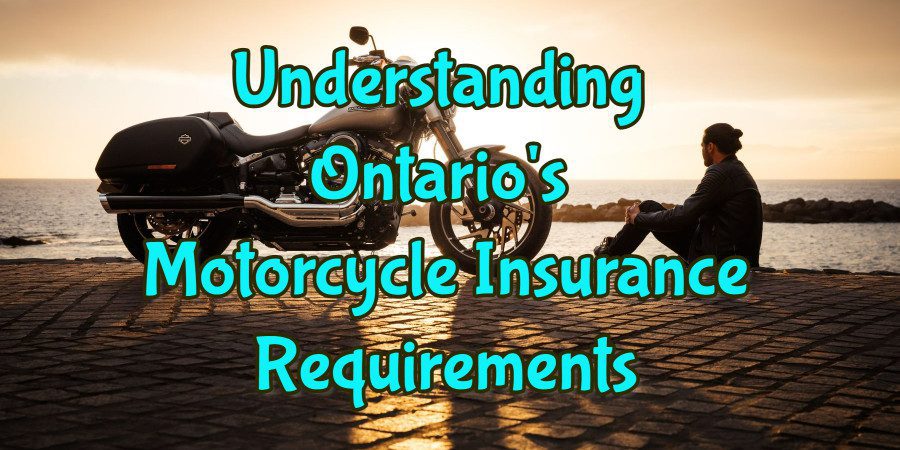
Riding Safe and Insured: A Guide to Understanding Ontario’s Motorcycle Insurance Laws
Riding a motorcycle is an exhilarating experience, but it’s also important to ensure you’re properly insured to protect yourself and others on the road. In Ontario, all motorcycle riders must have insurance coverage that meets the government’s minimum requirements.
But what exactly are these requirements, and what are the pros and cons of each? This comprehensive guide will dive into Ontario’s motorcycle insurance laws and break down everything you need to know.
The Minimum Insurance Coverage Required in Ontario
The minimum insurance coverage required for motorcycles in Ontario includes:
- $200,000 third-party liability coverage
- Statutory accident benefits coverage
- Direct compensation-property damage coverage
- Uninsured automobile coverage
Third-Party Liability Coverage
Third-party liability coverage is mandatory for all motorcycle riders in Ontario. This coverage provides protection in case you are involved in an accident that results in injury or property damage to another person. If you’re found to be at fault for the accident, your third-party liability coverage will help cover the costs associated with any damages or injuries.
Pros
- Protects other drivers and passengers on the road
- Helps cover costs associated with damages and injuries
- Mandatory coverage ensures that all riders are protected
Cons
- Does not cover your injuries or property damage
- Coverage limits may not be sufficient for more serious accidents
Statutory Accident Benefits Coverage
Statutory accident benefits coverage provides additional protection in case of injury or death resulting from a motorcycle accident. This coverage includes medical expenses, income replacement, and caregiver benefits.
Pros
- Provides additional protection for you and your passengers in case of injury or death
- Can help cover medical expenses and lost income
Cons
- Benefits may not be sufficient for more serious injuries
- Coverage limits may not be sufficient for more serious accidents
Direct Compensation-Property Damage Coverage
Direct compensation-property damage coverage protects damage to your motorcycle and any property inside it due to an accident that is not your fault. This coverage is unique to Ontario and allows you to receive compensation directly from your insurance company rather than going through a third party.
Pros
- Protects your motorcycle and property in case of an accident
- Allows you to receive compensation directly from your insurance company
Cons
- Does not cover your injuries
- Coverage limits may not be sufficient for more serious accidents
Uninsured Automobile Coverage
Uninsured automobile coverage protects if you are involved in an accident with an uninsured or unidentified driver. This coverage also protects if you are involved in a hit-and-run accident.
Pros
- Protects in case of an accident with an uninsured or unidentified driver
- Protects in case of a hit-and-run accident
Cons
- Coverage limits may not be sufficient for more serious accidents
Optional Coverage
While the minimum insurance requirements are mandatory, riders can also add optional coverage to their policy. This can include coverage for:
- Collision or upset damage
- All perils coverage
- Comprehensive coverage
- Specified perils coverage
- Increased third-party liability coverage
Collision or Upset Damage Coverage
Collision or upset damage coverage protects your motorcycle in case of a collision or upset. This coverage can help cover the costs of repairing or replacing your motorcycle.
Pros
- Protects your motorcycle in case of a collision or upset
- It helps cover the costs associated with repairing or replacing your motorcycle
Cons
- May increase insurance premiums
- Coverage limits may not be sufficient for more serious accidents
All Perils Coverage
All perils coverage protects your motorcycle in case of any loss or damage, except for specific exclusions outlined in your policy.
Pros
- Provides comprehensive protection for your motorcycle
- Covers a wide range of losses or damages, except for specific exclusions
Cons
- May increase insurance premiums
- Coverage limits may not be sufficient for more serious accidents
Comprehensive Coverage
Comprehensive coverage protects your motorcycle in case of any loss or damage, including theft, vandalism, and weather-related damage.
Pros
- Provides comprehensive protection for your motorcycle
- Covers a wide range of losses or damages, including theft, vandalism, and weather-related damage
Cons
- May increase insurance premiums
- Coverage limits may not be sufficient for more serious accidents
Specified Perils Coverage
Specified perils coverage protects your motorcycle in case of specific perils outlined in your policy, such as fire, theft, or attempted theft.
Pros
- Protects specific perils outlined in your policy
- It may be less expensive than comprehensive coverage
Cons
- It may not provide as comprehensive protection as other coverage options
- Coverage limits may not be sufficient for more serious accidents
Increased Third-Party Liability Coverage
Increased third-party liability coverage provides additional protection if you are found to be at fault for an accident resulting in significant damages or injuries.
Pros
- Provides additional protection in case of significant damages or injuries
- Can help cover costs associated with legal fees and settlements
Cons
- May increase insurance premiums significantly
- Coverage limits may not be sufficient for more serious accidents
Factors Affecting Insurance Premiums
Several factors can impact your motorcycle insurance premiums in Ontario, including:
- Your driving record
- The type of motorcycle you own
- Your age and experience as a rider
- Where you live
- How often do you ride
- The level of coverage you choose
It’s important to shop around and compare insurance quotes from different providers to find the coverage that best meets your needs at a price you can afford.
Helmet Laws in Ontario
In addition to insurance requirements, all motorcycle riders in Ontario must wear a helmet that meets government safety standards. Failure to do so can result in fines and penalties.
Questions
Can I still get motorcycle insurance if I have a poor driving record?
You can still get motorcycle insurance if you have a poor driving record. However, your premiums may increase due to the increased risk associated with your driving history.
Are there any discounts available for motorcycle insurance in Ontario?
Some insurance providers offer discounts for motorcycle riders who complete safety courses, have a good driving record, or insure multiple vehicles with the same provider.
Do I need to notify my insurance provider if I modify my motorcycle?
Yes, you must notify your insurance provider if you modify your motorcycle. Failure to do so can result in a denial of coverage in an accident.
Is it possible to get insurance coverage for a vintage or classic motorcycle in Ontario?
Yes, some insurance providers offer coverage specifically for vintage or classic motorcycles. However, these policies may have different requirements and limitations than standard motorcycle insurance policies.
What should I do if I’m involved in a motorcycle accident in Ontario?
If you’re involved in a motorcycle accident in Ontario, you must contact your insurance provider as soon as possible to report the accident. You should also seek medical attention if necessary and gather information from other parties involved in the accident, including witnesses.
Conclusion
Understanding Ontario’s motorcycle insurance laws is crucial for anyone who plans to ride a motorcycle in the province. By ensuring that you have the proper insurance coverage and are following helmet laws, you can protect yourself in case of an accident and avoid any penalties for non-compliance.
In summary, the mandatory minimum insurance coverage includes third-party liability coverage, statutory accident benefits coverage, direct compensation-property damage coverage, and uninsured automobile coverage.
Optional coverage includes collision or upset damage coverage, all perils coverage, comprehensive coverage, specified perils coverage, and increased third-party liability coverage. Factors that can impact insurance premiums include your driving record, the type of motorcycle you own, your age and experience, where you live, how often you ride, and the level of coverage you choose.
